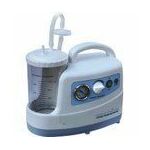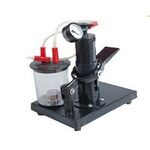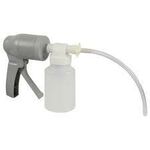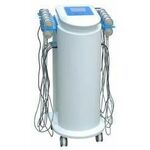What is a Suction Machine?
A suction machine, also called an aspirator, is an essential medical device commonly used in hospitals, clinics, and home care settings. It is designed to remove unwanted fluids like mucus, saliva, blood, or vomit from a patient’s airway, including the mouth, throat, or lungs.
The suction apparatus works by creating negative pressure to gently remove unwanted fluids from a patient’s airway. There are various types of suction machines available in the market, each designed with specific features to meet different medical needs. Whether you call it a suction machine or an aspirator, this essential device plays a key role in maintaining airway hygiene and supporting patient care.
Common Uses and Applications of a Suction Machine:
- Hospitals and Clinics: Used during surgeries, emergencies, and in ICUs to clear airways and support breathing.
- Pediatric and Adult Care Centers: Assist patients, both children and adults, who can’t clear their airways, especially those with chronic conditions.
- Home Healthcare: Helpful for bedridden or post-surgery patients at home. Easy for caregivers to use for daily respiratory care.
Parts of a Suction Machine:
- Suction Pump – Creates the vacuum needed to suction fluids.
- Collection Jar/Canister – Collects the suctioned fluids or secretions.
- Tubing – Connects the suction pump to the collection jar and to the suction catheter.
- Suction Catheter – The tube is inserted into the patient to remove fluids.
How Does a Suction Machine Work?
- First, the machine is turned on. Once it’s switched on, the machine starts making suction power, kind of like a gentle vacuum cleaner.
- A tube is connected to the patient. A soft tube is placed in the patient’s mouth, throat, or sometimes in the nose – wherever the fluid (like mucus, saliva, or blood) needs to be removed.
- It creates suction (vacuum pressure). The machine pulls out the fluid through the tube using gentle suction. It doesn’t hurt – it just helps clear the airway.
- Fluids are collected in a container. All the unwanted fluids go into a special jar attached to the machine. This keeps everything clean and safe.
- The airway becomes clear. After suctioning, the person can breathe more easily because nothing is blocking their throat or lungs.
- Used when patients can’t do it themselves. This is especially helpful for people who can’t cough or spit out the fluid, like after surgery, in an emergency, or if they are on a ventilator.
Types of Suction Machines:
Suction machines come in different types, and their prices vary depending on the features and design. Here's a brief look:
- Electric Suction Machines: These run on electricity and are commonly used in hospitals or for home care. They are easier to use and more powerful. Most have settings to control the suction level. Prices range from ₹7,000 to ₹1,55,000.
- Portable Suction Machines: These are small, light, and work on batteries, making them easy to carry. They’re great for home use or emergencies. Even though they’re compact, they still provide strong suction. Prices range from ₹4,000 to ₹30,500.
- Manual Hand Suction Machine: These machines don’t need electricity. You create suction by pumping with your hand, which makes them useful in places without power or during emergencies. Manual hand suction machines are affordable and usually cost between ₹1,000 and ₹3,000 in India.
- Manual Foot Suction Machine: These machines work without electricity. You use your foot to create suction, making them useful in places without power or during emergencies. Manual suction machines are budget-friendly and usually cost between ₹1,500 to ₹5,000 in India.
Explore Suction Machine Price and Models:
The price of a suction machine depends on the types, brands, models and, features (like suction control and portability), and whether it has one or two jars.
In India, suction machine price starts from ₹1,000 and goes up to ₹40,000.
Suction units like Manual foot suction machine will cost you from ₹3000 to ₹6000.
And, the Manual hand suction machine price starts from ₹1,500 to ₹3,000.
A portable suction machine will cost you ₹3,500 to ₹6,000.
The electric suction machine price is comparatively high, you can get the electric suction unit at the price of ₹12,000 to ₹30,000. Depending on the brands and models.
Suction Machine Price List According to Types:
S. No. | Types of Suction Machine | Min Price | Max Price |
1 | Electric Suction Machine | ₹7,000 | ₹1,55,000 |
2 | Portable Suction Machine | ₹4,000 | ₹30,500 |
3 | Manual Foot Suction Machine | ₹1,000 | ₹20,000 |
4 | Manual Hand Suction Machine | ₹1,000 | ₹3,000 |
Factors to Consider Before Buying a Suction Machine:
- Performance (LPM): Make sure the machine has enough suction power to remove fluids properly.
- Portability: Think about the size and weight of the machine, especially if you need to move it between rooms or take it while traveling.
- Power Source: Check if it runs on electricity, battery, or both, depending on where you’ll be using it.
- Noise Level: Choose a machine that doesn’t make too much noise, especially if it will be used often or in quiet places.
- Ease of Cleaning: Pick a machine that’s easy to clean and maintain so it stays hygienic and lasts longer.
- Accessory Compatibility: Make sure it works with standard parts like catheters, filters, and canisters.
- Durability and Warranty: Look at how strong the machine is built and how long the warranty lasts—it shows how reliable it might be.
- Cost: Check the price and choose one that fits your budget and needs.
Buy the Best Suction Machine Online from Biomed Suppliers for Your Facility:
If you’re planning to buy a medical suction machine for your clinic, hospital, or healthcare center, you might be wondering where to get it and how much it will cost.
No need to search more. Visit our website, Biomed Suppliers, where you’ll find a wide range of high-quality and durable suction machines. We also offer suction machine parts and accessories at affordable prices compared to other sellers.
We have top brands like Anand, Niscomed, Medsun, and Yuwell. So go ahead, check out our collection and choose the machine that fits your needs best.
Suction Machine Price List According to Top Brands:
Benefits of Buying from Biomed Suppliers:
Biomed Suppliers offers many benefits when purchasing suction machines:
- Wide Product Range: Choose from over 100 products by more than 25 trusted brands.
- Genuine Products: All products are 100% original and certified.
- Flexible Payment Options: Pay in parts or choose Cash on Delivery.
- Installation Support: On-site setup available after delivery.
- GST Invoice: Get a proper GST invoice for clear and legal billing.
Stationary vs. Portable Suction Machines: How to Choose the Right One:
Choosing between a stationary and a portable suction machine depends on how it will be used and how mobile the patient is.
Stationary Suction Machines are larger, electric-powered units designed for fixed setups like hospitals, clinics, or home care. They’re ideal for continuous, heavy-duty use in one place.
For example, the Anand Electric Suction Machine, Hi-Vac For Lipo is a powerful unit made for liposuction and high-demand procedures—reliable, easy to use, and built for tough clinical work.
Another model, like the Anand Electric Suction Machine, HI-VAC MS, is compact yet strong, perfect for general medical use and easy to move around when needed.
Portable Suction Machines are small, easy-to-carry units made for emergencies, home care, or travel—anywhere you need mobility. These machines are often battery-powered or manual, so they don’t rely on electricity.
For example, the Anaesthetics India Foot Operated Suction Unit is a manual device that works without power, perfect for areas with limited electricity.
The Anaesthetics India Hand Suction Unit is even more compact, great for quick suction during emergencies, and easy to handle on the go.
Key Difference: Both portable and stationary machines effectively clear airways, but the main difference lies in power and use. Stationary machines need a fixed power source and are ideal for hospitals or clinics, while portable ones offer flexibility and can be used anywhere, even without electricity.
Suction Machine – Maintenance Tips:
- Clean after every use – Wash the parts with soap and water.
- Disinfect – Use a proper disinfectant to keep it germ-free.
- Check for damage – Look for cracks, leaks, or worn parts.
- Dry properly – Let all parts dry before using or storing.
- Store in a clean place – Keep away from dust and moisture.
- Check filters – Replace them if dirty.
- Test the machine – Make sure the suction is working well.
- Follow the manual – Use the guide that came with the machine.
Frequently Asked Questions:
What is a suction machine used for?
A suction machine is used to remove fluids like mucus, saliva, or blood to help keep the airway clear and make breathing easier.
What is the price range of a suction machine?
The price of a suction machine depends on the types, brands, models and, features (like suction control and portability), and whether it has one or two jars.
In India, suction machine price starts from ₹1,000 and goes up to ₹40,000.
How does a suction machine work?
The machine creates suction using a pump, which pulls out fluids through a tube connected to the patient.
What is the principle of suction?
The principle of suction is creating a vacuum to pull fluids or air from one place to another.
Popular Categories:
Electric Suction Machine | Portable Suction Machine | Manual Foot Suction Machine | Manual Hand suction pump | Liposuction Machine | Theater Suction Trolley | Silicone Vacuum Cup | ECG Machine | Single Channel ECG Machine | 3 Channel ECG Machine | 6 Channel ECG Machine | 12 Channel ECG Machine | Ventilator Machine | ICU Ventilator | Oxygen Concentrator Machine | Portable Oxygen Concentrator | Home Oxygen Concentrator | Nebulizer Machine | Dialysis Machine | DVT Pump | Defibrillator | AED Machine | Cardiac Monitor | Multipara Monitor | Pulse Oximeter | Patient Monitor | Fetal Monitor | BiPAP & CPAP Machine | OT Table | C Arm Machine | Laryngoscope | Anesthesia Machine | Patient Warmer | Autoclave Machine | X Ray Machine | CR & DR System | Ultrasound Machine | MRI Machine | CT Scan Machine | Littmann Stethoscope | TMT Machine | Holter Monitor | Spirometer Machine | Audiometer | EMG Machine | EEG Machine | Stretcher | Hospital Chair | Hospital Beds | Hospital Trolley | Biochemistry Analyzer | CBC Machine | Centrifuge Machine | Urine Analyzer | Lab Shakers and Rotators | ESR Analyzer | Surgical Microscope | ECG Paper | Insulin Pump | Syringe Pump | Feeding Pump | Oximeter | Stethoscope |






